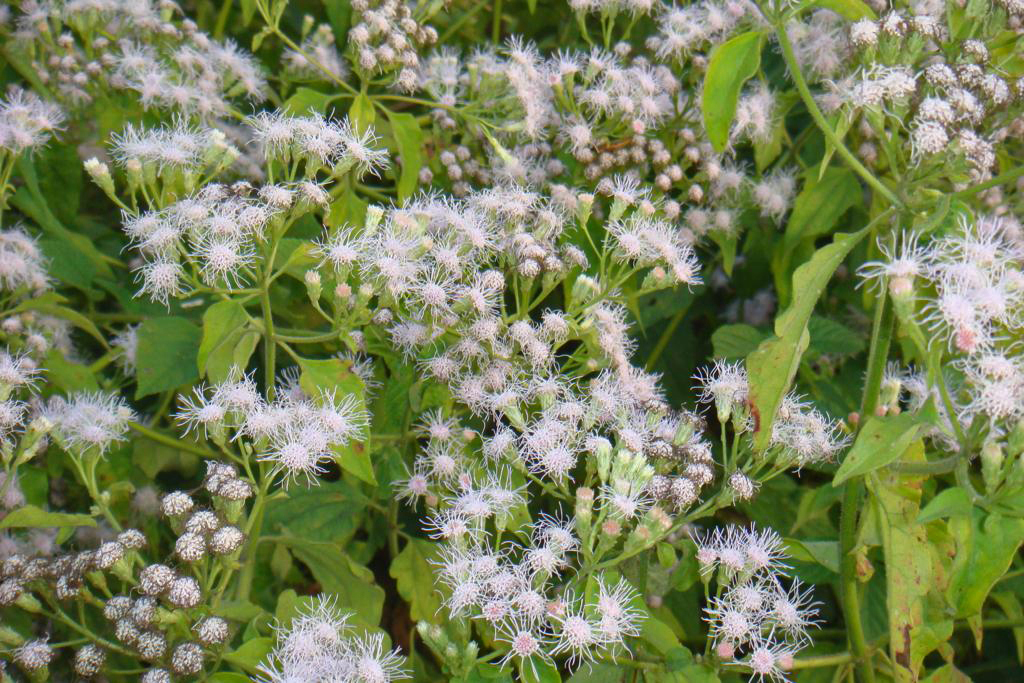- A 2016 study ranks Nepal fourth globally in vulnerability to invasive species threats, particularly in agriculture.
- Yet despite drafting a management strategy to deal with the issue seven years ago, Nepal has still not finalized and implemented it.
- The country has identified 182 alien flowering plant species, with 27 considered invasive, affecting forests, agriculture and wildlife habitats.
- Experts stress the importance of swift action, noting that the window of opportunity to effectively manage invasive species is small.
KATHMANDU — Nepal ranks as one of the countries most vulnerable to invasive species, yet still hasn’t finalized a management strategy to address the issue.
A draft of the strategy, considered vital for the country to tackle the growing threat of invasive plant and animal species and meet its international obligations, was prepared seven years ago by the then Ministry of Forest and Soil Conservation. Another draft of the same document was prepared by the Forest Research and Training Centre under what is today the Ministry of Forest and Environment.
“That the document hasn’t been finalized even seven years after the first draft was prepared shows that the government hasn’t prioritized such an important issue,” said Bharat Babu Shrestha, a botany professor at Tribhuvan University in Kathmandu.
According to a 2016 study, Nepal ranks fourth in terms of relative threat to agriculture from invasive species, given its trade ties with India and agricultural imports, agricultural diversity, history of spread of invasive species, and economic and geographic and climatic factors.

The country had previously committed, in a report to the United Nations’ Convention on Biological Diversity, to prepare and implement a management plan for problematic invasive species, especially plants considered weeds, by 2010. However, 14 years on, it still hasn’t done so, said Shrestha, who has done pioneering research in invasive alien species in Nepal. Similarly, most of the targets set by the National Biodiversity and Strategy and Action Plan (2014-2020) to control and manage the spread of invasive species have also not been met.
Most of the research on invasive species has focused on plants because of the potential impact they can have on forests and agriculture, both of which are vital to the country’s economy. According to a 2021 study, a total of 182 alien flowering plant species have been documented in Nepal, of which 27 are considered invasive.
Shrestha said drawing from conversations with various stakeholders, including farmers, the water hyacinth (Pontederia crassipes), devil weed (Chromolaena odorata), lantana (Lantana camara) and bitter vine (Mikania micrantha) — all native to the Americas — are the top four invasive weed species found inside protected areas of the country.
Similarly, in the case of agricultural land, Western Hemisphere species like Mexican poppy (Argemone mexicana), billygoat weed (Ageratum conyzoides), whitetop weed (Parthenium hysterophorus) and flossflower (Ageratum houstonianum) are the major invasive alien species.

These plants not only impact agricultural productivity; they also degrade habitats of threatened megafauna such as tigers (Panthera tigris) and greater one-horned rhinos (Rhinoceros unicornis).
“In the context of invasive alien species, research shows that the window of opportunity to deal with the threat is very small,” Shrestha said. “If we take swift action in the early days of the invasion, the invasive species can be rooted out quickly and it doesn’t take a lot of resources to do that.”
However, once this window closes and the invasive species proliferates, it can get out of control and even containing its spread requires a lot of resources, he said.
Invasive species such as devil weed (also known as Siam weed, though it’s not native to Southeast Asia) have become pervasive in eastern and central parts of the country, but not yet in the west. “So there is a window of opportunity to stem its proliferation,” Shrestha said. “We had said the same thing about Ageratum houstonianum 20 years ago, but because of inaction it has spread beyond our control.”
Even when invasive weed species are detected in Nepal, local communities and forestry managers often don’t know how to deal with them. And by the time they get the requisite knowledge, they don’t have adequate resources to take action, said Shyam Kumar Shah, senior ecologist at the Department of National Parks and Wildlife Conservation.
Having a formalized strategy document in place would provide some direction toward managing the situation, stakeholders say.
“We understand that this is a pressing issue and we are working on the strategy, giving it top priority,” said Rajendra K.C., director-general of the Forest Research and Training Centre. He said his office is waiting for constructive feedback on the current draft from stakeholders so that it can be implemented without any obstacles.
Prakash Paudel, senior plant protection officer at the Plant Quarantine and Pesticide Management Center, said the next step in controlling the proliferation of invasive species should also include preparation of an official list of high-priority targets. “Such a list can help raise awareness among the public,” he added.
Paudel added that existing laws and regulations allow his office to prepare and publish such a list. However, government offices such as the FRTC, which have the technical and research capabilities, should provide needed support.

In addition to invasive weeds, certain nonnative fish species have also been discovered in Nepal’s river systems. However, officials don’t have any plans to eradicate them in their early days of proliferation. An Amazonian catfish, Pterygoplichthys disjunctivus, was recently found in eastern Nepal. Similarly, species such as glass fish (Chanda nama) and Nile tilapia (Oreochromis niloticus) have also been found in different lakes here, said Hari Sharma, associate professor of zoology at Tribhuvan University. Rainbow trout (Oncorhynchus mykiss) could also invade freshwater ecosystems if farmers aren’t made aware of its consequences, he added.
“There are some who say that we shouldn’t waste resources in a war that we can’t win,” Shrestha said, referring to the race against time to contain invasive species. “However, if we utilize the window of opportunity, we can definitely stop the proliferation of invasive species.”
Banner Image: Lantana flowers bloom in Bangladesh. Image courtesy of IUCN Bangladesh.
Abhaya Raj Joshi is a staff writer for Nepal at Mongabay. Find him on 𝕏 @arj272.
Citations:
Paini, D. R., Sheppard, A. W., Cook, D. C., De Barro, P. J., Worner, S. P., & Thomas, M. B. (2016). Global threat to agriculture from invasive species. Proceedings of the National Academy of Sciences, 113(27), 7575-7579. doi:10.1073/pnas.1602205113
Shrestha, B. B., & Shrestha, K. K. (2021). Invasions of alien plant species in Nepal. Invasive Alien Species, 2, 168-183. doi:10.1002/9781119607045.ch20
Nepal’s water hyacinth helps exotic fish invade, harming native species: Study
